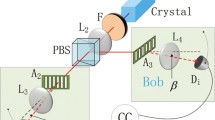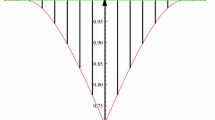Abstract
In this article, we review the relationship between Bell inequality and its associated polytopes and introduce a method to extend Bell inequalities to more parties. According to this method, the Bell inequality in n parties can be extended to n + 1 parties. Such generalization is nontrivial in that there is stronger violation for new inequalities.
Similar content being viewed by others
Explore related subjects
Discover the latest articles and news from researchers in related subjects, suggested using machine learning.References
Bell J S. On the Einstein-Podolsky-Rosen paradox. Physics, 1964, 1: 195–200
Einstein A, Podolsky B, Rosen N. Can quantum-mechanical description of physical reality be considered complete? Physics Review, 1935, 47: 777–780
Clauser J F, Horne M A, Shimony A, et al. Proposed experiment to test local hidden-variable theories. Physical Review Letters, 1969, 23: 880–884
Clauser J F, Horne M A. Experimental consequences of objective local theories. Physical Review D, 1974, 10: 526–535
Greenberger D M, Horne M A, Zeilinger A. In: Kafatos M, ed. Bell’s Theorem, Quantum Theory, and Conceptions of the Universe. Dordrecht: Kluwer Academic Publisher, 1989, 69
Ardehali M. Bell inequalities with a magnitude of violation that grows exponentially with the number of particles. Physical Review A, 1992, 46: 5375–5378
Belinskii A V, Klyshko D N. Interference of light and Bell’s theorem. Physics-Uspekhi, 1993, 36: 653–693
Werner R F, Wolf M W. All-multipartite Bell-correlation inequalities for two di-chotomic observables per site. Physical Review A, 2001, 64: 032112
Weinfurter H, Zukowski M. Four-photon entanglement from down-conversion. Physical Review A, 2001, 64: 010102(R)
Zukowski M, Brukner Č. Bells theorem for general N-qubit states. Physical Review Letters. 2002, 88: 210401
Pitowsky I. Quantum probability-quantum logic (Lecture notes in physics 321). Foundations of Physics Letters, 1989; 2(3):297–298
Pitowsky I, Svozil K. Optimal tests of quantum nonlocality. Physical Review A, 2001, 64:014102
Sliwa C. Symmetries of the Bell correlation inequalities. Physics Letters A, 2003, 317: 165
Wu X H, Zong H S. A new Bell inequality for three spin-half particle system. Physics Letters A, 2003, 307: 262
Wu X H, Zong H S. Violation of local realism by a system with N spin-1/2 particles. Physical Review A, 2003, 68: 032102
Laskowski W, Paterek T, Zukowski M, et al. Tight multipartite Bell’s inequalities involving many measurement settings. Physical Review Letters. 2004, 93: 200401
Paterek T, Laskowski W, Zukowski M. On series of multiqubit Bell’s inequalities. Modern Physics Letters A, 2006, 21: 111
Pitowsky I. The range of quantum probability. Journal of Mathematical Physics, 1986, 27(6): 1556–1565
Avis D, Imai H, Ito T. Two-party Bell inequalities derived from combinatorics via triangular elimination. Journal of Physics A: Mathematical and General, 2005, 38: 10971–10987
Avis D, Imai H, Ito T. On the relationship between convex bodies related to correlation experiments with dichotomic observables. Journal of Physics A: Mathematical and General, 2006, 39: 11283–11299
Pironia S. Lifting Bell inequalities. Journal of Mathematical Physics, 2005, 46: 062112
Zukowski M. All tight multipartite Bell correlation inequalities for three dichotomic observables per observer. arXiv:quant-ph/0611086
Wieśniak M, Badziag P, Zukowski M. Explicit form of correlation function three-settings tight Bell inequalities for three qubits. Physical Review A, 2007, 76: 012110
Wu Y C, Wieśniak M, Badziag P, et al. Extending Bell inequalities to more parties. Physical Review A, 2008, 77: 032105
Ekert A K. Quantum cryptography based on Bells theorem. Physical Review Letters, 1991, 67: 661–663
Scarani V, Gisin N. Quantum communication between N partners and Bell’s inequalities. Physical Review Letters, 2001, 87: 117901
Brukner C, Zukowski M, Pan J W, et al. Bells inequalities and quantum communication complexity. Physical Review Letters, 2004, 92: 127901
Acin A, Gisin N, Masanes L, et al. Bell’s inequalities detect efficient entanglement. International Journal of Quantum Information, 2004, 2: 23
Gisin N. Bell inequalities: many questions, a few answers. arXiv: quant-ph/0102021
Author information
Authors and Affiliations
Corresponding author
Rights and permissions
About this article
Cite this article
Wu, Y., Guo, G. High-dimension Bell inequalities. Front. Comput. Sci. China 2, 190–192 (2008). https://doi.org/10.1007/s11704-008-0023-x
Received:
Accepted:
Published:
Issue Date:
DOI: https://doi.org/10.1007/s11704-008-0023-x




